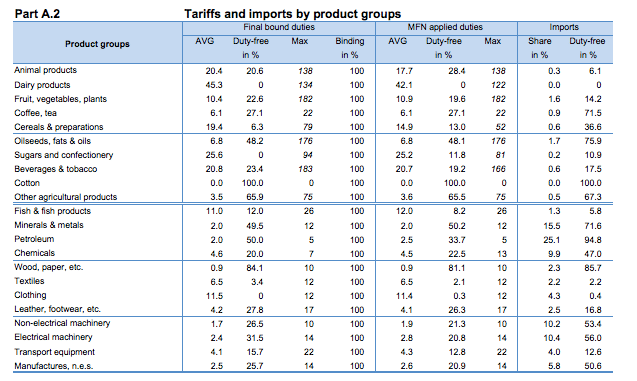Definition: Trade barriers are government policies which place restrictions on international trade. Trade barriers can either make trade more difficult and expensive (tariff barriers) or prevent trade completely (e.g. trade embargo)
Examples of Trade Barriers
- Tariff Barriers. These are taxes on certain imports. They raise the price of imported goods making imports less competitive.
- Non-Tariff Barriers. These involve rules and regulations which make trade more difficult. For example, if foreign companies have to adhere to complex manufacturing laws it can be difficult to trade.
- Quotas. A limit placed on the number of imports
- Voluntary Export Restraint (VER). Similar to quotas, this is where countries agree to limit the number of imports. This was used by the US for imports of Japanese cars.
- Subsidies. A domestic subsidy from government can give the local firm a competitive advantage.
- Embargo. A complete ban on imports from a certain country. E.g. US embargo with Cuba.
Real-world examples of trade barriers
Chinese import tariffs. This link shows that China is reducing its import tariffs on luxury foreign goods such as Scottish Whiskey from 10% to 5%. It is a sign the Chinese government want to encourage consumer spending. BBC – China cuts import tariffs
50% tariff on imports of washing machines. The US Trade body has recommended tariffs of 50% on imports of washing machines – especially from South Korean manufacturers IG and Samsung. The Trade body is concerned IG are selling washing machines below cost and dumping surplus supply on the US market. US manufacturer Whirlpool brought the case.
Custom duties post-Brexit. If the UK leaves the Single Market as part of Brexit process there will be custom forms and regulations to meet on exports and imports. These rules and regulations provide a significant barrier to trade.
Quotas on low-tariff food. The EU has a quota for allowing a certain number of food items to enter without attracting tariffs.
VER. In 1981, the US implemented a 1981 voluntary restraint agreement limited the Japanese to exporting 1.68 million cars to the U.S. per year. This limited the import of cars, though ironically made it more profitable for Japanese exporters. With a limit on the quantity, they could increase prices. Another consequence of this is that Japanese firms began assembling cars in the US and entering into partnerships with American car companies to get around the export restrictions.
Subsidies. The EU gives €39 billion to farmers in direct subsidies. Indirectly, this makes EU agricultural exports more competitive and gives EU farmers an advantage in trade.
Embargoes are usually implemented for political reasons. After Fidel Castro came to power, the US imposed a trade embargo on Cuba, which was strictly enforced.
EU tariffs
Source: WTO World Tariff rates
Related
- Benefits and costs of tariffs
- Effect of US tariffs on Chinese imports
- Trade Creation
- Examples of protectionism
Published 12 Nov 2019, Tejvan Pettinger. www.economicshelp.org


great………… l learn a lot……… it is clearly explained
I thank the writers of these book as it give clear and brief summary of notes.
This site is exptional……….I’ve grasped the concepts
Well explained
Wow! Thank you so much. Very well explained.
Very simple n easy to get through it, well explained.
Wow!! Bririent very well explained thank you so much 🙏
Thank you for your help
What about globalization and liberalization of foreign exchange plus cumbersome export producer
Great explanation